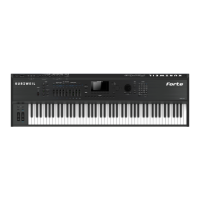Multi Edit Mode
CONTROLS Page
9-15
Bump tapers velocity response to resemble a bell curve, so that notes are loudest when your
keystrike velocity is 64. Notes get softer as the keystrike velocity approaches 0 or 127.
e next four velocity curves are Reverse Linear (Rvrs Linear), Reverse Expand (Rvrs
Expand), Reverse Compress (Rvrs Compress), and Reverse Crossfade (Rvrs Crossfade).
ese taper velocity in reverse of the ve curves we just covered. For example, Reverse
Linear’s response is such that striking a key harder will produce a lower volume, striking it
softer will produce a higher volume, and so on. is provides a convenient way to achieve
negative scaling, by letting you set one parameter instead of two.
LoVel, HiVel
LoVel (Low Velocity) and HiVel (High Velocity) set the minimum and maximum velocity
limits that the current zone transmits.
A keystroke in the current zone whose velocity — after it has been scaled and oset —
is below the minimum does not generate a Note On. Neither does a keystroke whose
velocity after processing is above the maximum. ese parameters are useful for “velocity
switching”—having a key play dierent sounds depending on how hard you strike it.
e values can be anywhere from 1 to 127. As with other parameters, zones can overlap or
be totally discrete, or be identical. Usually, LoVel will have a smaller value than HiVel, but as
with LoKey and HiKey, you may also create a gap in velocity response, by setting HiVel to a
lower value than LoVel.

